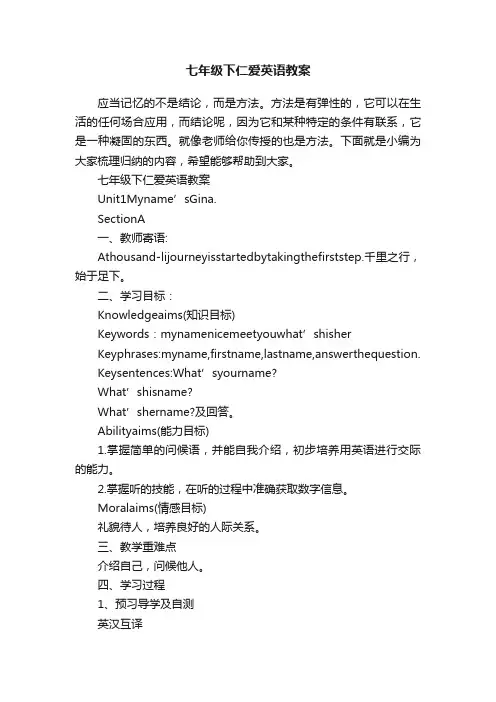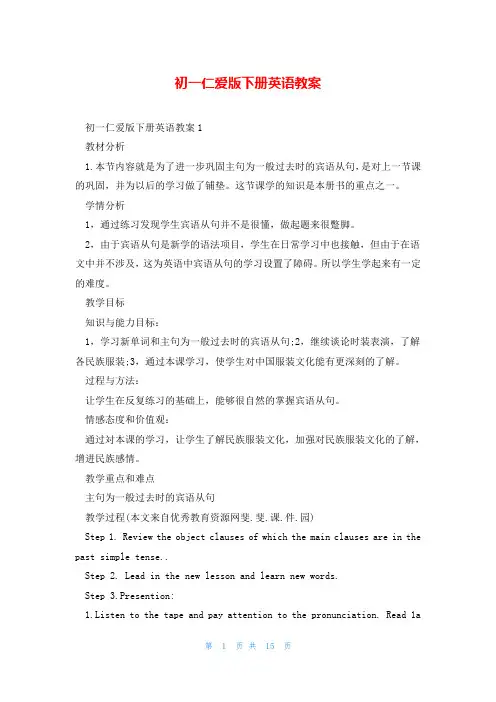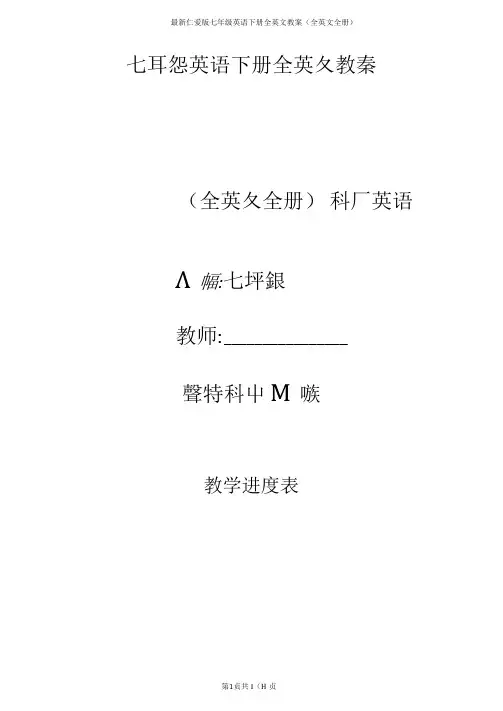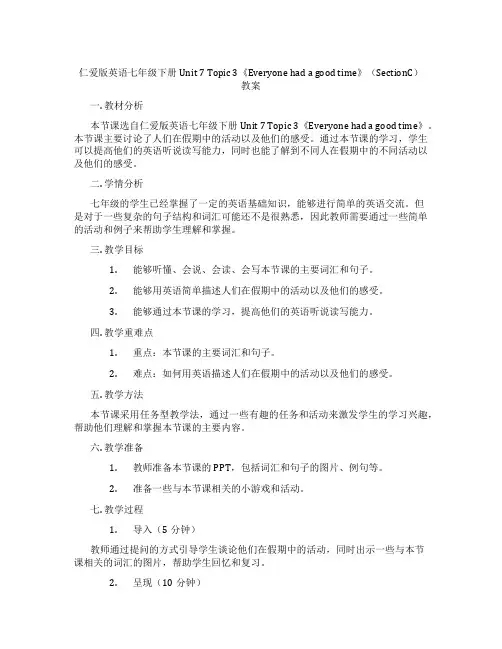仁爱版七年级下册英语教案
七年级下仁爱英语教案

七年级下仁爱英语教案应当记忆的不是结论,而是方法。
方法是有弹性的,它可以在生活的任何场合应用,而结论呢,因为它和某种特定的条件有联系,它是一种凝固的东西。
就像老师给你传授的也是方法。
下面就是小编为大家梳理归纳的内容,希望能够帮助到大家。
七年级下仁爱英语教案Unit1Myname’sGina.SectionA一、教师寄语:Athousand-lijourneyisstartedbytakingthefirststep.千里之行,始于足下。
二、学习目标:Knowledgeaims(知识目标)Keywords:mynamenicemeetyouwhat’shisherKeyphrases:myname,firstname,lastname,answerthequestion.Keysentences:What’syourname?What’shisname?What’shername?及回答。
Abilityaims(能力目标)1.掌握简单的问候语,并能自我介绍,初步培养用英语进行交际的能力。
2.掌握听的技能,在听的过程中准确获取数字信息。
Moralaims(情感目标)礼貌待人,培养良好的人际关系。
三、教学重难点介绍自己,问候他人。
四、学习过程1、预习导学及自测英汉互译_________2.好的,令人愉快的______________3.too___________4.遇见______5.your____________6.his_________7.她的名字______2、自主学习①.onenum.1,一:Oneandtwomakesthree.一加二等于三。
adj.①一个:Ihaveonebook.我有一本书。
②有一(天):Onedayhewillunderstandyou.有一天他会理解你的。
②meet/mi:t/v.遇到,碰到【记忆法】-ee-双写,与meat为同音词。
【考点】tomeetsb.(orsth.)遇到某人/某事:Nicetomeetyou.初次见面时的客套话,不是初次见面时则用see。
仁爱英语七年级下册教案

仁爱英语七年级下册教案教案标题:《仁爱英语七年级下册教案》教案目标:1. 帮助学生掌握本册课本中的英语知识和技能。
2. 培养学生的听、说、读、写的能力,提高他们的英语综合运用能力。
3. 培养学生的学习兴趣和学习策略,激发他们学习英语的积极性。
教学重点:1. 学习并掌握本册课本中的重点词汇和句型。
2. 培养学生的听力和口语表达能力。
3. 培养学生的阅读理解能力和写作能力。
教学难点:1. 帮助学生克服英语学习中的困难和障碍,提高他们的学习自信心。
2. 培养学生的英语学习兴趣,提高他们的学习动力。
教学准备:1. 课本《仁爱英语七年级下册》2. 多媒体设备和教学软件3. 学生练习册和作业本4. 课堂活动和游戏的准备材料教学步骤:第一课时:1. 导入:通过展示一些与本课话题相关的图片或视频,引发学生的兴趣,并激发他们对英语学习的热情。
2. 情景对话:教师与学生进行一段关于日常生活的对话,引导学生运用所学知识进行表达和交流。
3. 听力训练:播放录音,让学生听并完成相关的听力练习,培养他们的听力理解能力。
4. 语法讲解:通过示范和解释,教授本课的重点语法知识,并进行相关练习。
5. 互动活动:设计小组活动或角色扮演,让学生在实际情境中运用所学知识,提高口语表达能力。
第二课时:1. 复习:通过复习上节课的重点内容,巩固学生的学习成果。
2. 阅读理解:教师给学生分发阅读材料,让学生阅读并回答相关问题,培养他们的阅读理解能力。
3. 语法练习:设计语法练习题,让学生运用所学语法知识进行练习,提高他们的语法运用能力。
4. 写作训练:引导学生根据所给提示,写一篇关于自己生活的短文,培养他们的写作能力。
5. 结束:总结本节课的学习内容,鼓励学生对自己的学习进行反思和总结。
教学评估:1. 课堂练习:通过课堂练习,检查学生对所学知识的掌握程度。
2. 作业布置:布置相应的练习作业,巩固学生的学习成果。
3. 个别辅导:对学习困难的学生进行个别辅导,帮助他们克服学习障碍。
初一仁爱版下册英语教案

初一仁爱版下册英语教案初一仁爱版下册英语教案1教材分析1.本节内容就是为了进一步巩固主句为一般过去时的宾语从句,是对上一节课的巩固,并为以后的学习做了铺垫。
这节课学的知识是本册书的重点之一。
学情分析1,通过练习发现学生宾语从句并不是很懂,做起题来很蹩脚。
2,由于宾语从句是新学的语法项目,学生在日常学习中也接触,但由于在语文中并不涉及,这为英语中宾语从句的学习设置了障碍。
所以学生学起来有一定的难度。
教学目标知识与能力目标:1,学习新单词和主句为一般过去时的宾语从句;2,继续谈论时装表演,了解各民族服装;3,通过本课学习,使学生对中国服装文化能有更深刻的了解。
过程与方法:让学生在反复练习的基础上,能够很自然的掌握宾语从句。
情感态度和价值观:通过対本课的学习,让学生了解民族服装文化,加强对民族服装文化的了解,增进民族感情。
教学重点和难点主句为一般过去时的宾语从句教学过程(本文来自优秀教育资源网斐.斐.课.件.园)Step 1. Review the object clauses of which the main clauses are in the past simple tense..Step 2. Lead in the new lesson and learn new words.Step 3.Presention:1.Listen to the tape and pay attention to the pronunciation. Read 1ain different ways to learn it2. Let the students answer some questi. And then fill in blanks according to 1a.Step 4. PracticeLead into Part 2and practice the object clauses of which the main clauses are in the past simple tense.Step 5.Colidation :Step 6.Homework:教学环节一,复习二,导入三,呈现四,练习五,巩固六,作业复习宾语从句,然后利用宾语从句引入新课,并展示图片,学习生词,进而学习少数民族服装,处理第三部分。
最新仁爱版七年级英语下册全英文教案(全英文 全册)

七年级英语下册全英文教案(全英文全册)科目:英语年级:七年级教师:登特科中心校教学进度表课程表时间星期课节星期一星期二星期三星期四星期五8:30--9:10 第1节9:20--10:00 第2节10:10--10:50 第3节11:00--11:40 第4节12:50--13:30 第5节13:40--14:20 第6节14:30--15:10 第7节15:20--16:00 第8节教学计划Step4Practice(10s)1.Do 2a. Study the example to understand the two ways ofexpressing means of transportation. Then fill in the blanksin 2a. Discuss and check the answers.2.Make the students find the rules of two ways ofexpressing the same meaning by themselves. Help themcheck the rules.3.Do 2b. Ask and answer questions about the pictures in 2a ,using two ways of expressing means of transportation.Help the students to express correctly.4.Do 3. Read the form in 3 before listening. Predict thelistening material. Learn the new words: watch TV,soccer/football, movie/film. Then listen to the passageabout Nancy’s activities and check the correct answersindividually. Then check the answersHomework: Blackboard Design1.Recite 10 words andfinish workbook.2.Practice theconversation of 1a;3.Preview Section C-1a.Topic 1 I usually come to school by subway. Section B1. I always get up at six o’clock.2. The early bird catches the worm.3. I usually come to school on foot, but sometimes by bike.I seldom walk to school. I never come to school by subway.2. Li Xiang often comes to school by bike.Li Xiang often rides a bike to school.Thinking after teaching:_________________________________________________________________ _________________________________________________________________ _________________________________________________________________ _________________________________________________________________Topic: Unit 6 Topic 1SectionA Date of Teaching: March 29thTeaching Targets: Knowledge and ability aims:1.Grasp the new words :beautiful, garden, bedroom, second, floor, and so on, upstairs, kitchen, dining room, living room, bathroom, first2.Correctly use bearing prepositions and prepositional phrases,on,next to3.Be able to use the there be pattern to describe the room and the basic furnishings in the scene dialogue;Emotion aims:1.love their living environment;2.To be able to actively cooperate with peers, participate in classroom activities, bold practice.Important &Difficult Points: In the constitutional dialogue, learn to use there be sentence patterns to describe each room and the basic furnishingsTeachingaids:PPT Type New Period: One Steps/Time Teaching Procedures 二次修改Step1 Revision(10 s)Step2 Presentation(10 s) Step3 Consolidatedtion(10 s) 1. Present new words with the help of the flashcards.2. Help the students revise expressions and grammer in lastunit.1.Do 2a & 2b. Listen to the tape of 2a and match thewords or phrases with the pictures in 2a individually.Then check the answers.2.Make up new sentences according to the picture in 2a,using “there be” structure.3.listen to the tape of 1a choose the correct answer in1b,then check the answers.1.Listen to the tape again and fill in the blanks according to1a individually about 1c. Then check the answers .2.Practice 1a in pairs. Then some pairs act out theHelp the students goon learning thewords about thefurniture and homeitems.。
最新仁爱版七年级英语下册全英文教案(全英文全册)

七耳怨英语下册全英夂教秦(全英夂全册)科厂英语Λ幅:七坪銀教师: ________________聲特科屮M嗾教学进度表姓名修或麻债亿录班级座位表最新仁爱版七年级英语下册全英文教案(全英文全册)1. Do 2a. StUdy the example to UnderStand the two WayS Of expressing means Of transportation. Then fill in the blanks in 2a. DiSCUSS and CheCk the answers ・2. Make the StUdentS find the rules Of two WayS Of expressing the Same meaning by themselves. HeIP them CheCk the rules.3. Do 2b. ASk and answer questions about the PiCtUreS in 2a , USing two WayS Of expressing means Of transportation. HeIP the StUdentS to express correctly.4. Do 3. Read the form in 3 before IiStening ・ PrediCt the IiStening material ・ Leam the new words: WatCh TV. SOCCer/football, movie/film. Then IiSten to the PaSSage about NanCy ,s activities and CheCk the COrreCt answers individually. Then CheCk the answersBlaCkbOard DeSignTOPiC 1 I USUany COme to SChOOl by subway. SeCtiOn B 1. IaIWaySgetIJPdtSiX (/clock ・ 2. The early bird CatCheS the WOrm ・3.I IISllaIIy COme to SChOOl On foot, but SOmetimeS by bike ・I SeldOm Walk to SChOOL I never COnIe to SChOOl by subway. 2. Li Xiang Often COmeS to SChOOl by bike ・Li Xiang Often rides a bike to school.never(()%) Sel(IOIn SOnletinIrS Often IISuaIIy always(100%)I 1—^1I —I ——~~Thinking after teaching:Step4 PraCtiCe (IOS)Homework:1 .Recite 10 WOrdS and finish WOrkbOOk ・ 2. P ι*actice the COnVerSatiOn Of la;3. Preview SeCtiOn C-la.StePl ReViSe (IOS)Step2 PreSentatiOn (IOS)Step3COnSOIidatiOn(IOS)Step4 PraCtiCe (IOS)1. H ave a diction.(IOwords)2. Help the StUdentS to revise the WOrdS about the days Of a Week and subjects.1. PreSent new WOrdS and new PattemS With the help Of the flashcardsand context.2. Do la. LOOk at the PiCtUre in la. PrediCt the IiStening material in la. Then IiSten to the tape and COmPlete the two COkImnS in the table in lb. Then IiSten again and COmPlete the third CoIUmn in lb. CheCk the answers.1. R ead Ia after the tape.2.r ∏ιen PraCtiCetlιeCOnVerSatiOn in Ia in PairS ・ 3. Do lb. L∞k at the table in lb. Try to Say the SentenCeS With the help Of the table.(让学生说完整的句子)1 .Create SitUatiOnS to PreSent the new phrase. CheCk the answers ・Make the StUdentS PraCtiCe the WOrdS Of SUbjeCtS orally.2. Ask and answer questions With your Partner With the PhraSeS in the box in 2a.3. Do 2b. Make the StUdentS PraCtiCe the expressions about IikeS and dislikes ・4. Work in PairS ・ LOOk at the PiCtUreS in 2b and make UP new conversations. PraCtiCe the COnVerSatiOnS in PairS ・5. D O 3.Make the StUdentS USe the expressions about IikeS and dislikes in Oral WOrk and Written WOrk after Iearning ・StePl ReViSe (IOS)Step2 PreSentatiOn (IOS)Step3 COnSOIidatiOn(IOS)Step4 PraCtiCe (IOS)l.Have a diction.(IOwords)2Revise the WOrdS about the days Of a Week and subjects. 3.Show SOme PhOtOS about sch∞l activities to arouse the StudentSqinterests.1. D o la. PreSent new WOrdS in the context. PrediCt the reading materialbefore reading ・2. L OOk at the PiCtUreS in la. Read the StatementS before reading the material. Try to guess TrUe Or FaISe before reading ・3. R ead the PaSSage in Ia individually. CirCle TnJe Or False. Then CheCk your answers With your Partner.Help the StUdentS CheCk their answers WhiIe reading ・1 .Try to SUmmariZe the main idea Of each ParagraPh.Help the StUdentS Iearn to USe their OWn WOrdS to SUnImariZe the main idea ・2.Do lb. Read Ia again and fill in the blanks in Ib individually. CheCk the answers ・1. Look at the news and POSterS in2. Try to guess the COntent in them. Then read the news and POSterS about HU Biιι,s interesting SChOOl Iife and fill iιι the blanks iιι the following table.2. Make the StUdentS Iearn to make POSterS and news by themselves ・3. Do 4a. Read the WOrdS in 4a individually. Then read the WOrdS to your partner.4. Do 4b. Read the WOrdS On PPT together, where, bear, there, chair, near, here ・ Read the Chant after the tape ・ Pay attention to the rhythm. Then PraCtiCe the Chant in PairS ・最新仁爱版七年级英语下册全英文教案(全英文全册)。
仁爱版英语七年级下册Unit 7 Topic 3《Everyone had a good time》

仁爱版英语七年级下册Unit 7 Topic 3《Everyone had a good time》(SectionC)教案一. 教材分析本节课选自仁爱版英语七年级下册Unit 7 Topic 3《Everyone had a good time》。
本节课主要讨论了人们在假期中的活动以及他们的感受。
通过本节课的学习,学生可以提高他们的英语听说读写能力,同时也能了解到不同人在假期中的不同活动以及他们的感受。
二. 学情分析七年级的学生已经掌握了一定的英语基础知识,能够进行简单的英语交流。
但是对于一些复杂的句子结构和词汇可能还不是很熟悉,因此教师需要通过一些简单的活动和例子来帮助学生理解和掌握。
三. 教学目标1.能够听懂、会说、会读、会写本节课的主要词汇和句子。
2.能够用英语简单描述人们在假期中的活动以及他们的感受。
3.能够通过本节课的学习,提高他们的英语听说读写能力。
四. 教学重难点1.重点:本节课的主要词汇和句子。
2.难点:如何用英语描述人们在假期中的活动以及他们的感受。
五. 教学方法本节课采用任务型教学法,通过一些有趣的任务和活动来激发学生的学习兴趣,帮助他们理解和掌握本节课的主要内容。
六. 教学准备1.教师准备本节课的PPT,包括词汇和句子的图片、例句等。
2.准备一些与本节课相关的小游戏和活动。
七. 教学过程1.导入(5分钟)教师通过提问的方式引导学生谈论他们在假期中的活动,同时出示一些与本节课相关的词汇的图片,帮助学生回忆和复习。
2.呈现(10分钟)教师通过PPT展示本节课的主要词汇和句子,同时给出一些例句,帮助学生理解和掌握。
3.操练(10分钟)教师通过一些简单的活动和游戏,帮助学生练习本节课的词汇和句子。
例如,教师可以学生进行角色扮演,让学生用英语描述他们在假期中的活动以及他们的感受。
4.巩固(5分钟)教师通过一些练习题帮助学生巩固本节课的内容。
例如,教师可以让学生完成一些选择题或者填空题,让学生在实践中运用本节课的词汇和句子。
仁爱版七年级下册英语教案
仁爱版七年级下册英语教案一、教学目标本节课的教学目标是:1.了解和学习有关健康和健康饮食的词汇和表达方式。
2.能够描述健康和不健康的生活习惯。
3.能够使用所学词汇和表达方式对健康问题进行讨论和提建议。
二、教学重点1.学习与健康和健康饮食相关的词汇和表达方式。
2.能够描述健康和不健康的生活习惯。
三、教学难点1.能够使用所学词汇和表达方式对健康问题进行讨论和提建议。
四、教学准备1.教师准备好与健康和健康饮食相关的词汇和图片。
2.准备课件和板书。
五、教学过程1. 导入新课教师出示一张健康饮食的图片,让学生观察并讨论:“你能看出这个图片里有哪些食物吗?这些食物看起来健康吗?为什么?”引出学习健康和健康饮食的话题。
2. 学习新词汇教师出示健康和不健康的生活习惯的图片,例如晚上早早睡觉、坚持锻炼、多吃水果和蔬菜等,然后带领学生学习并掌握这些新词汇。
单词词性释义healthy adj.健康的unhealthy adj.不健康的exercise n.锻炼fruit n.水果vegetable n.蔬菜3. 练习新词汇教师设计一些练习题,让学生巩固新词汇的记忆和理解。
1.Fill in the blanks.•Eating too much junk food is __________ for your health.•You should do more __________.•Apples and oranges are __________.•Carrots and tomatoes are __________.2.Translate the following sentences into English.•坚持锻炼对保持健康很重要。
•不要吃太多垃圾食品。
•香蕉是水果,洋葱是蔬菜。
4. 综合训练教师给学生提供一些关于健康问题的情景,让学生用所学词汇和表达方式进行讨论,并提出建议。
情景一:你的同学经常晚上玩电脑游戏,睡眠时间很短,经常感到疲劳和头痛。
2024年仁爱版英语七年级下教案【可下载打印】
2024年仁爱版英语七年级下教案【可打印】一、教学内容本节课选自2024年仁爱版英语七年级下册,主要涉及第二章第三节的内容,详细内容包括:一般现在时态的用法,日常作息时间的表达,以及相关词汇和句型的学习。
二、教学目标1. 让学生掌握一般现在时态的用法,并能运用到实际情境中进行交流。
2. 培养学生运用英语表达日常作息时间的能力,增强语言实际运用能力。
3. 通过学习本节课的内容,提高学生的听说读写综合运用能力。
三、教学难点与重点1. 教学难点:一般现在时态的构成及用法,日常作息时间的表达。
2. 教学重点:句型“主语+动词原形/第三人称单数+其他”的运用,以及相关词汇的记忆。
四、教具与学具准备1. 教具:多媒体设备,PPT课件,黑板,录音机。
2. 学具:英语课本,练习册,笔记本,彩色笔。
五、教学过程1. 实践情景引入(5分钟)利用PPT展示不同时间段的图片,引导学生用英语描述图片内容,复习日常作息时间的表达。
2. 例题讲解(10分钟)讲解一般现在时态的用法,通过例句展示,让学生理解和掌握该时态的构成及用法。
3. 随堂练习(15分钟)课堂互动,让学生分组进行对话练习,用一般现在时态描述日常作息时间。
4. 巩固环节(10分钟)利用练习册上的题目,让学生独立完成,巩固所学知识。
5. 课堂小结(5分钟)6. 互动环节(10分钟)学生上台展示,用英语分享自己的日常作息时间。
7. 作业布置(5分钟)布置课后作业,强调作业要求和完成时间。
六、板书设计1. 一般现在时态的构成及用法2. 日常作息时间的表达3. 相关词汇和句型七、作业设计1. 作业题目:(1)用一般现在时态写一段话,描述你的日常作息时间。
(2)根据所给词汇,完成下列句子。
2. 答案:(1)I usually get up at 6:30 in the morning. After breakfast, I go to school at 7:30. I have lunch at 12:00 noon.In the afternoon, I get back home at 5:00. I do my homework and have dinner at 7:00. Finally, I go to bed at 9:30.(2)e.g. I often watch TV in the evening.八、课后反思及拓展延伸1. 课后反思:关注学生在课堂上的表现,针对学生的掌握情况,调整教学方法,提高教学效果。
仁爱版英语七年级下全册教案
仁爱版英语七年级(下)教案Unit 5一、【教学目标】(一)语言知识语音/t/ /d/ /ts/ /dz/ /tr/ /dr/ /l/ /m/ /n/词汇掌握wake,early, first,day, term,must,still,by,on foot,the same to,usually,always,Ms.,boat,ship,sea,train,by plane/air/airplane, etc.理解Subway Worm reporter,Net Bar,roller skating Measure dining hall,dormitory bookstore,etc.(二)语法1.一般现在时(Simple present)2.频度副词(Adverbs of frequency)never,seldom,sometimes,often,usually,always,once,twice3.现在进行时(Present continuous)I’m looking for a book.Are you doing your homework?Yes,I am./No,I m not.Is he/she...?Yes,he/she is./No,he/she isn’t.What are you doing now?I’m playing computer games.What is he/she doing?He/She is...4.谈论交通方式(Talking about means of transport)How do you usually go to school? I usually go to school by bike.(三)功能用语与话题1.采访(Interviews)Our guest today is Michael from Class 2,Grade 1.2.谈论日常生活(Talking about routines)3.学校建筑(School buildings)swimming pool,playground,library,dormitory,lab,canteen,gym4.谈论兴趣喜好(Talking about interests,likes and dislikes)I like the swimming pool best. Why do you like English? Because it’s interesting and easy.5.借物(Borrowing things)How long can I keep it? Two weeks.6.新闻(News)、海报(Poster)Attention,please! Here is the news.7.谈论学校活动、科目和时间表(Talking about school activities,subjects and timetable)8.谈论学校生活(Talking about school life)(四)能力培养【听】能听懂谈论校园生活中比较熟悉的话题,识别主题,获取主要信息。
仁爱版英语七年级下册教案
仁爱版英语七年级下册教案《仁爱版英语七年级下册教案》为题在七年级下学期的英语课程中,我们将继续使用仁爱版英语教材。
为了帮助学生更好地学习英语,我们准备了一份教案,旨在引导学生进行全面、系统的学习。
第一课:Unit 1 My School Day1. Learning Objectives- Enable students to talk about their school day in English. - Familiarize students with the vocabulary related to school subjects and daily routines.- Develop students' listening, speaking, reading, and writing skills.2. Warm-up- Show pictures of different school subjects and ask students to name them in English.- Play a short video clip of a typical school day routine and ask students to describe what they see.3. Vocabulary- Introduce new vocabulary related to school subjects and daily routines through flashcards, word games, and real-life examples.4. Listening- Play an audio recording of a student's school day routine and ask students to listen and fill in the missing information on a worksheet.5. Speaking- Divide students into pairs and ask them to interview each other about their typical school day routine using the targetvocabulary.6. Reading- Provide students with a short reading passage about a school day routine and ask them to answer comprehension questions.7. Writing- Ask students to write a short paragraph about their own school day routine, using the vocabulary and sentence structures learned in class.8. Extension Activities- Role play: Divide students into groups and ask them to act out a school day routine, using the target vocabulary and sentence structures.- Vocabulary word search: Provide students with a word search worksheet containing the vocabulary words learned in this unit.第二课:Unit 2 My Hobbies1. Learning Objectives- Enable students to talk about their hobbies in English.- Familiarize students with the vocabulary related to different hobbies.- Develop students' listening, speaking, reading, and writing skills.2. Warm-up- Show pictures of different hobbies and ask students to name them in English.- Play a short video clip of people engaging in different hobbies and ask students to describe what they see.3. Vocabulary- Introduce new vocabulary related to hobbies through flashcards, word games, and real-life examples.4. Listening- Play an audio recording of people talking about their hobbies and ask students to listen and match the hobbies with the correct person on a worksheet.5. Speaking- Divide students into groups and ask them to discuss their favorite hobbies using the target vocabulary. Each group should appoint a spokesperson to present their findings to the class.6. Reading- Provide students with a short reading passage about different hobbies and ask them to answer comprehension questions.7. Writing- Ask students to write a short paragraph about theirfavorite hobby, using the vocabulary and sentence structures learned in class.8. Extension Activities- Hobby showcase: Ask students to bring in an item or a picture related to their favorite hobby and present it to the class, explaining why they enjoy it.- Hobby survey: Divide students into pairs and ask them to conduct a survey among their classmates to find out the most popular hobbies in the class.第三课:Unit 3 My Family1. Learning Objectives- Enable students to talk about their family members in English.- Familiarize students with the vocabulary related to family members and relationships.- Develop students' listening, speaking, reading, and writingskills.2. Warm-up- Show pictures of different family members and ask students to name them in English.- Play a short video clip about a family gathering and ask students to describe what they see.3. Vocabulary- Introduce new vocabulary related to family members and relationships through flashcards, word games, and real-life examples.4. Listening- Play an audio recording of a person talking about their family and ask students to listen and answer comprehension questions.5. Speaking- Divide students into pairs and ask them to interview each other about their family members and relationships using the target vocabulary.6. Reading- Provide students with a short reading passage about a family and ask them to answer comprehension questions.7. Writing- Ask students to write a short paragraph about their own family, using the vocabulary and sentence structures learned in class.8. Extension Activities- Family tree: Ask students to create a family tree, labeling each family member with the appropriate vocabulary words.- Family interview: Divide students into pairs and ask them to interview their family members about their family history, traditions, and customs.本教案只写了前三课的内容,希望能够帮助学生更好地学习英语。
- 1、下载文档前请自行甄别文档内容的完整性,平台不提供额外的编辑、内容补充、找答案等附加服务。
- 2、"仅部分预览"的文档,不可在线预览部分如存在完整性等问题,可反馈申请退款(可完整预览的文档不适用该条件!)。
- 3、如文档侵犯您的权益,请联系客服反馈,我们会尽快为您处理(人工客服工作时间:9:00-18:30)。
Project English七下Unit 1 Our School LifeTopic 1 How do you usually come to school?Section A(Kangkang meets Jane and Helen at the school gate.)Kangkang: Hi, Jane and Helen. Happy New Year!Jane and Helen: The same to you. Nice to see you again, Kangkang. Kangkang: Nice to see you, too.Helen: Oh, your new bike looks very nice!Kangkang: Thank you.Helen: Do you often come to school by bike?Kangkang: Yes, I do. How do you usually come to school?Helen: I usually come to school by subway.How about you,Jane? Jane: I always come to school by bus. Oh, it's time for class. Come on!KEY POINTS①at the school gate "在校门口"②Happy new year! "新年快乐!"③the same to you = you too "你也是"。
④Nice to meet you, too. too "也"。
⑤Look (系动词) + adj.(形容词) “看起来像,,,/ 看上去,,,”。
⑥How ,,,? 表示对方式是提问。
⑦by(pre. 介词)+ 交通工具[如,plane/air, ship/sea/boat, car, bus,train, subway, taxi, bike] 表示“乘(坐),,,”。
⑧On(pre.)the / one's bike / train, 表示“在自行车/火车上”。
⑨in(pre.)the / one's car,表示“在汽车里”。
⑩It's time + for(pre.)+ V-ing(动词ing) / n.(名词)=It's time + to + V原(动词原形)表示“到,,,时间了”。
11come on"快点/ 加油"12辨析:come to "来,,, " ; go to "去,,, "13特例:go to ,,, on foot = walk to(pre.)+ ,,,14often " 经常" ; usually "通常" 二者通常用在一般现在时中。
Unit 1 Section BHelen: Michael, what time do you usually get up on weekdays?Michael: I always get up at about six o'clock.Helen: The early bird catches the worm. How do you usually go to school? Michael: I usually go to school on foot, but sometimes by bike.How about you? Helen: I seldom walk to school. I often go by subway. What about you, Sally? Sally: I never go to school by subway. I always take a bus.KEY POINTS①What time ,,, ? 询问时间,表示“几点了/ 什么时间?”;②get up 起床;◆on the weekdays在工作日(周一到周五);◆on the weekday在工作日(中的任一天);◆on the weekends在周末(周六周日);◆on the weekend在周末的任一天(周六或者周日);③at(pre.)+ 时间点,表示“在几点”;④The early bird catches the worm."早起的鸟儿有虫吃";early与late相对;⑤表示频率的副词:never seldom sometimes often usually always 100%从不很少有时经常通常总是⑥how about = what about,后面都+ V-ing / n.表示“,,,怎么样?”⑦短语互换:❖go to ,,,on foot = walk to ,,,“步行/ 走路去,,,”❖come/ go to school by bike = ride a bike to school “骑自行车去,,,”❖go home by subway/ car/ bus = take the subway/ a car/ a bus home(adv. ) 【特别说明:home(adv. )为副词,所以它前面不加介词(pre.)如to, in等】⑧短语积累:get up early/ late; walk to sp.(someplace某地); do one's homework;help my parents; see a movie/ film看电影; watch TV/ a game;at school; in the evening; as always=as usual“像往常一样”Unit 1 Section CInterniewer: Good evening, boys and girls! Welcome our new friend, Michael.He's from America. Hello, Michael!Michael: Hello!Interniewer: We'd like to know about the school life of American students.How do they usually go to school?Michael: Well, many students take a yellow school bus or walk to school.Very few students ride bikes.Interniewer: Where do they usually have lunch?Michael: They usually have lunch at school. They seldom eat outon school days.Interniewer: Do they have a short rest after lunch?Michael: No, they don't.Interniewer: What time is school over, then?Michael: At about 3 o'clock.Interniewer: What do they do in their free time?Michael: They often play basketball or soccer, go swimming and so on. Interniewer: And how often do they have ball games?Michael: Four times a year.Interniewer: Well, I'm sorry we have no more time. Nice talking to you.Thank you.①Good morning / after / evening!②welcome (v.) + sb. 欢迎某人;welcome + to + 地点---》Welcome to China.③be from = come from "来自"④'d like是would like 的缩写形式,would like + to + V. ,“想要做某事”⑤know about 知道(关于),了解;of“,,,的”⑥American students 美国学生⑦take a yellow school bus; ride bikes⑧few "很少",修饰可数名词,表否定,"几乎没有";a few + 可复n. "一些";very few 很少。
与few相像的是little,只不过little/ a little + 不可数n.⑨eat out外出吃饭;have a (short) rest (稍作)休息;after lunch 午饭后⑩on school day s在校期间11be over 结束12At about 3 o'clock.在大约三点;“在几点”,用介词at13in one's free time "在某人的空闲时间",如in my/her/his/your free time.14play basketball; have ball games举行球赛; have a ball game举行一场球赛当然也可以have a basket/football game; have basketball/football games等;go swimming 去游泳,推而广之go + V-ing 结构,“去做某事”15and so on“等等”,一般用于句末,表示列举事物。
16How often 用来对频率进行提问,回答如Four times a year."一年四次"17be sorry对,,,抱歉;have (no)more time"(没)有更多时间"18Nice doing sth. = Nice to do sth. 很高兴做某事19短语积累:go fishing; do one's homework做作业; do housework做家务;go to the park; read books; in the library在图书馆20名言名句:1. Work must come first! 工作(学习)必须放在第一位!2. - How often do you come to the library?(你多久来一次图书馆?)- Very often.(“经常。
